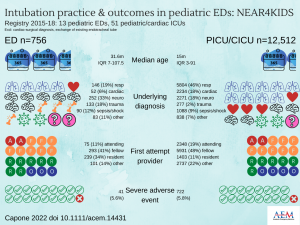AEM Publishes Report on Pediatric Intubation in Emergency Departments
While tracheal intubation characteristics vary between pediatric emergency departments and intensive care units, outcomes are similar.
DES PLAINES, ILLINOIS, UNITED STATES, April 13, 2022 /EINPresswire.com/ -- While tracheal intubation (TI) characteristics vary between pediatric emergency departments (EDs) and intensive care units (ICUs), outcomes are similar. That is the conclusion of the study titled Intubation practice and outcomes among pediatric emergency departments: A report from National Emergency Airway Registry for Children (NEAR4KIDS), to be published in the April 2022 issue of Academic Emergency Medicine (AEM), a peer-reviewed journal of the Society for Academic Emergency Medicine (SAEM).The lead author of the study is Christine A. Capone, MD, MPH, is a pediatric cardiologist in the division of pediatric critical care medicine in the department of pediatrics at the Steven and Alexandra Cohen Children's Medical Center, New Hyde Park, New York. Results of the study are discussed in a recent AEM podcast.
The primary aim of this study was to describe the patient, provider, and practice characteristics of ED TIs within the multi-center National Emergency Airway Registry for Children (NEAR4KIDS) registry in contrast to TIs in the ICU. The study found that shock and limited mouth opening were independently associated with adverse TI events in the ED.
TI for critically ill or injured children is a lifesaving yet high-risk procedure, occurring an average of once every five days in pediatric EDs. These patients may have acute physiologic derangements, trauma, and/or a full stomach, all of which can contribute to an unpredictable clinical course. Because TIs are relatively uncommon in EDs, providers can have difficulty with procedural skill maintenance.
Multi-center, comprehensive analysis of procedural indications, risk factors, provider characteristics, and equipment choice for pediatric ED TIs has not yet been conducted. These data are essential for identification of areas where patient safety and procedural success can be optimized. Examples of quality improvement work in pediatric airway management exist in the ICU and ED setting; however, an understanding of their similarities and differences is essential to replication and furthering of prior successes.
###
ABOUT ACADEMIC EMERGENCY MEDICINE
Academic Emergency Medicine, the monthly journal of Society for Academic Emergency Medicine, features the best in peer-reviewed, cutting-edge original research relevant to the practice and investigation of emergency care. The above study is published open access and can be downloaded by following the DOI link: 10.1111/acem.14431. Journalists wishing to interview the authors may contact Tami Craig at tcraig@saem.org.
ABOUT THE SOCIETY FOR ACADEMIC EMERGENCY MEDICINE
SAEM is a 501(c)(3) not-for-profit organization dedicated to the improvement of care of the acutely ill and injured patient by leading the advancement of academic emergency medicine through education and research, advocacy, and professional development. To learn more, visit saem.org.
Tami Craig
SAEM
+1 847-813-5734
email us here
Visit us on social media:
Facebook
Twitter
LinkedIn
Legal Disclaimer:
EIN Presswire provides this news content "as is" without warranty of any kind. We do not accept any responsibility or liability for the accuracy, content, images, videos, licenses, completeness, legality, or reliability of the information contained in this article. If you have any complaints or copyright issues related to this article, kindly contact the author above.

